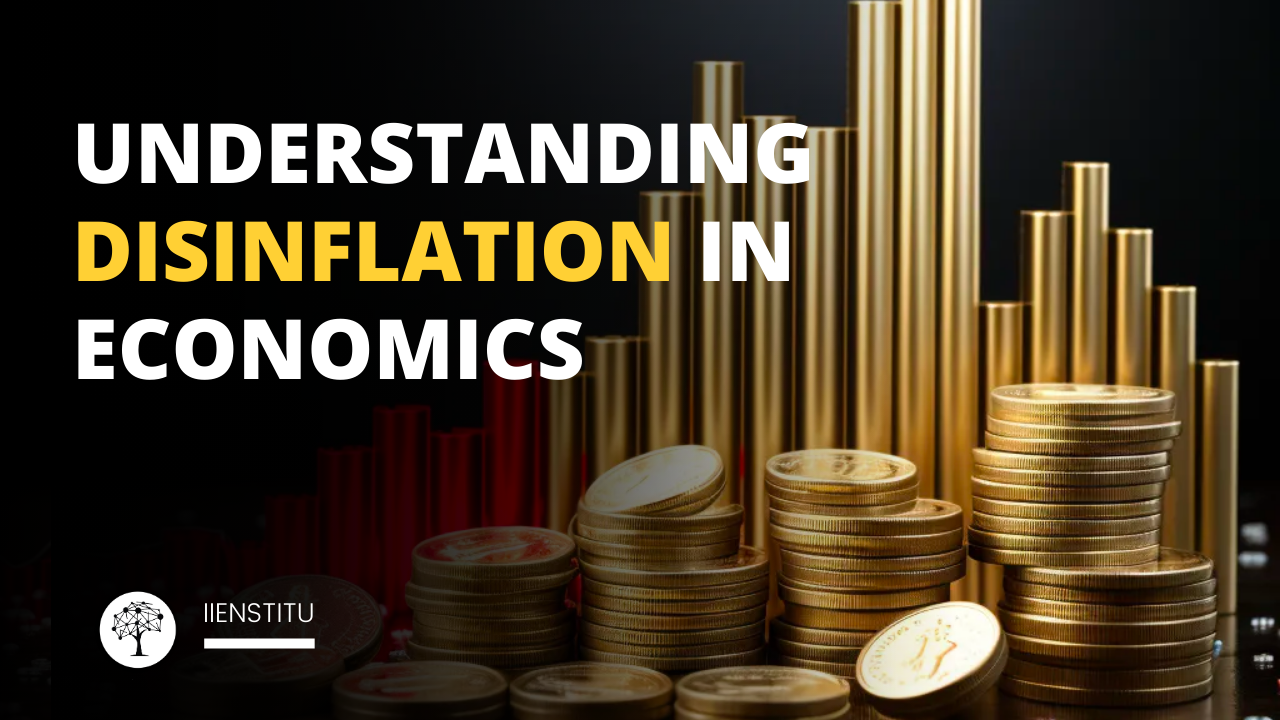
In the dynamic world of economics, terms like inflation, deflation, and disinflation often intertwine, leading to confusion. Disinflation, a term frequently mentioned in economic discussions and policies, stands distinct yet closely related to its counterparts.
In this comprehensive guide, we'll demystify the concept of disinflation, drawing parallels with risk management practices and online courses. We'll clearly differentiate it from deflation and stagflation and delve into its profound significance within the economic landscape.
What is Disinflation?
At its core, disinflation refers to a slowdown in the rate of inflation. Unlike deflation, where the general price level decreases, disinflation depicts a scenario where the rate of price increase moderates.
It's not about prices dropping; it's about prices rising at a slower pace. This distinction is crucial in understanding economic policies and market reactions.

Disinflation vs. Deflation vs. Stagflation
To fully grasp the concept of disinflation, it's essential to delineate it from deflation and stagflation. Here's a closer look at each:
Disinflation: A decrease in the rate of inflation. For example, if the inflation rate drops from 4% to 2%, this is disinflation. It indicates a slowing pace in the increase of prices across the economy.
Deflation: This is when the overall price level in an economy starts falling. Deflation is more than just a slowdown in the rate of price increases—it's a negative inflation rate, indicating a decrease in the general price level.
Stagflation: A situation where the economy experiences stagnant growth, high unemployment, and high inflation all at once. It's a problematic scenario as the usual tools to combat inflation (like tightening monetary policy) can exacerbate unemployment and economic stagnation.
Each of these terms – "deflation and disinflation," "deflation vs disinflation," and "deflation vs disinflation vs stagflation" – illuminates different economic conditions, each with unique implications and policy responses.
Example of Disinflation
An apt illustration of disinflation would be when the annual inflation rate went from 5% in one year to 3% in the following year. This reduction in the inflation rate exemplifies disinflation, where the economy is still experiencing inflation, but at a reduced pace.
What is Disinflation and How Does It Occur?
The phenomenon of disinflation is not merely a theoretical concept but a practical economic event with real-world implications. It occurs when there is a deceleration in the rate of inflation over a certain period.
This could be due to various factors such as governmental monetary policies, reduced demand for goods and services, or technological advancements leading to greater efficiency.
Disinflation Example: An example of disinflation would be when a country's annual inflation rate decreases from 4% to 2%. This change signifies a reduction in the rate at which prices are increasing. It's important to distinguish this from deflation, where the general price level would actually be falling.
Why Disinflation Happens and Its Impact
Several factors can lead to disinflation. One common cause is the intervention by policymakers who adjust monetary policies to control inflation.
For instance, central banks might increase interest rates to reduce the money supply, which can slow down inflation and lead to disinflation.
However, disinflation can also have unintended consequences. While it can signify a stabilizing economy, excessive disinflation may lead to a slowdown in economic growth.
This is because consumers and businesses might delay purchases in anticipation of lower prices in the future, decreasing overall economic demand.

The Volcker Disinflation and Other Cases
One of the most notable examples of disinflation in history is the Volcker Disinflation. In the early 1980s, Federal Reserve Chairman Paul Volcker implemented policies that significantly increased interest rates to combat the high inflation of the 1970s. This drastic measure successfully reduced inflation but also led to a recession.
The Volcker Disinflation is often considered a success because it helped to stabilize the economy in the long run, but it also highlights the potential negative aspects of disinflation, such as increased unemployment and slowed economic growth during the adjustment period.

Modern Views on Disinflation
In recent times, the concept of disinflation has been discussed in the context of current economic policies. For instance, Federal Reserve Chairman Jerome Powell has spoken about “transitory disinflation”, indicating a temporary phase of slowing inflation. This reflects a modern understanding that disinflation can be a part of the natural ebb and flow of economic cycles.
Disinflation is a nuanced and critical concept in economics. It reflects a decrease in the rate of inflation, which can have both positive and negative implications for an economy. Understanding disinflation, especially in relation to deflation and stagflation, is essential for interpreting economic trends and policies.
Frequently Asked Questions
What is disinflation?
Disinflation is a decrease in the rate of inflation – a slowdown in the rate at which prices are increasing. Unlike deflation, where prices generally fall, disinflation represents a scenario where the pace of price increase is slowing down.
Understanding Disinflation in Economic Terms
Disinflation is a nuanced concept in economics, crucial for understanding the dynamics of market economies. Unlike inflation, where the general price level of goods and services rises, or deflation, where it falls, disinflation refers to a slowdown in the rate of inflation. It's an intermediate economic condition where the inflation rate is declining but still positive.
The Mechanics of Disinflation
The process of disinflation typically occurs when there is a decrease in the demand for goods and services, often as a result of tightening monetary policies by central banks. When central banks raise interest rates, borrowing costs increase, leading to a decrease in spending and investment. This reduced demand tends to slow the rate of price increases, leading to disinflation.
Economic Indicators and Disinflation
Various economic indicators can signal the onset of disinflation. These include a decrease in the Consumer Price Index (CPI) growth rate, Producer Price Index (PPI), and wage growth. It's crucial to monitor these indicators as they provide insights into the overall economic health and the effectiveness of monetary policies.
Implications of Disinflation
Disinflation can have both positive and negative implications for an economy. On the positive side, disinflation can indicate that an overheated economy is cooling down, leading to more stable and sustainable growth. It can also increase the purchasing power of consumers, as the slower rise in prices eases the strain on their spending.
On the downside, if disinflation trends towards deflation, it can lead to delayed consumer spending. Consumers may postpone purchases in anticipation of lower prices in the future, which can further slow economic growth. Moreover, disinflation can lead to lower profit margins for businesses, as they might be unable to pass on increased costs to consumers in the form of higher prices.
Historical Examples of Disinflation
Historical instances, such as the Volcker disinflation in the early 1980s, provide valuable insights into the mechanics of disinflation. In this case, the Federal Reserve, under Chairman Paul Volcker, raised interest rates dramatically to combat high inflation. This led to a period of significant disinflation, ultimately stabilizing the economy but also causing a short-term recession and increased unemployment.
Current Perspectives on Disinflation
In the modern economic landscape, disinflation is often discussed in the context of monetary policies and their impacts. Central banks around the world closely monitor inflation rates and adjust policies accordingly to maintain economic stability. The current discourse, including statements from figures like Federal Reserve Chairman Jerome Powell, often revolves around managing the balance between stimulating economic growth and controlling inflation rates.
What is disinflation in economics?
In economics, disinflation refers to the period during which the inflation rate is declining but remains positive. It indicates a moderation in the rate at which the overall price level of goods and services is rising.
Disinflation: A Conceptual and Practical Understanding
In the realm of economics, disinflation holds a special place as it signifies a unique state of the economy. It is a term that often needs clarification and deeper understanding due to its subtle yet important distinction from similar economic terms like inflation and deflation.
The Essence of Disinflation
Disinflation refers to the slowing down of the inflation rate. It is a phase where the price level of goods and services is increasing but at a decreasing rate. This phenomenon is indicative of a shift in the economic environment, often influenced by various macroeconomic factors.
How Disinflation Manifests in an Economy
Inflation Rate Dynamics: A key indicator of disinflation is the gradual decline in the annual inflation rate, as measured by indices like the Consumer Price Index (CPI).
Central Bank Policies: Often, disinflation is a result of deliberate monetary policy actions by central banks aiming to control hyperinflation or manage economic overheating.
Market Reactions: The stock and bond markets may react positively to disinflation, as it often signals effective economic management and reduced risks of runaway inflation.
Implications of Disinflation in Economics
Disinflation can have wide-ranging implications on various aspects of an economy:
Consumer Purchasing Power: As inflation slows, the erosion of consumer purchasing power is mitigated, potentially boosting consumer confidence and spending.
Debt Dynamics: The real burden of debt may not escalate as rapidly in a disinflationary environment, providing relief to borrowers.
Investment Decisions: Investors might adjust their strategies, as the expectations for inflation impact the returns on different asset classes.
Disinflation vs. Other Economic Conditions
Understanding disinflation also involves recognizing how it differs from deflation and inflation:
Inflation: While inflation signifies a general rise in prices, disinflation is specifically about the rate of this increase slowing down.
Deflation: Unlike deflation, where the general price level falls, disinflation still involves rising prices, albeit at a slower rate.
Disinflation in economics is a nuanced concept that represents a decrease in the rate of inflation. Its occurrence, implications, and the strategies to manage it are critical in understanding and navigating the broader economic environment.
What is the difference between deflation and disinflation?
The key difference lies in the direction of price changes. Deflation is characterized by falling prices, indicating a negative inflation rate. In contrast, disinflation is a reduction in the rate of inflation - prices are still rising, but at a slower pace than before.
Defining Deflation and Disinflation
To understand the economic landscape, distinguishing between deflation and disinflation is crucial. While these terms are often used interchangeably, they represent significantly different economic phenomena.
Deflation: A Closer Look
Deflation is characterized by a general decline in prices across an economy. It's more than just a reduction in the rate of inflation; it's a negative inflation rate. Deflation occurs when the overall price level of goods and services decreases over a period, typically reflecting a decrease in the supply of money and credit or a drop in aggregate demand.
Causes of Deflation
Deflation can be caused by a variety of factors:
Increased Productivity: Technological advancements or improvements in processes that lead to lower production costs can result in deflation.
Reduced Consumer Spending: Economic downturns or a lack of consumer confidence can lead to decreased spending, pushing prices down.
Contractionary Monetary Policies: Central banks might tighten monetary policies, reducing the money supply and leading to lower prices.
Impact of Deflation
Deflation can lead to a downward economic spiral:
Decreased Consumer Spending: As prices fall, consumers may delay purchases, anticipating even lower prices, which can further decrease demand.
Increased Debt Burden: The real value of debt increases, making it more expensive for borrowers to service their debts.
Business Profitability: Lower prices can lead to reduced revenues and profits for businesses, potentially leading to cutbacks and layoffs.
Disinflation: Understanding the Concept
Disinflation, on the other hand, is a slowdown in the rate of inflation. It occurs when the inflation rate decreases but remains positive. This means prices are still rising, but at a slower pace than before.
Occurrence of Disinflation
Disinflation often happens due to:
Tightening of Monetary Policies: When central banks raise interest rates to control inflation.
Decrease in Demand: Reduction in consumer demand can lead to a surplus of goods and services, slowing down price increases.
Global Economic Factors: Changes in global markets, such as reduced demand for commodities, can contribute to disinflation.
Implications of Disinflation
The effects of disinflation can be complex:
Economic Stability: Controlled inflation can lead to a more stable economic environment.
Monetary Policy Adjustments: Central banks may use disinflation as a cue to adjust interest rates or alter monetary policies.
Consumer Behavior: Slowly rising prices might encourage consumer spending, as opposed to the delaying tactics seen in deflation.
Distinguishing the Two
The key difference between deflation and disinflation lies in their impact on the economy. Deflation is often seen as a negative economic indicator, suggesting a decrease in demand or an oversupply of goods and services. Disinflation, however, can be indicative of successful monetary policy, bringing an overheated economy to more sustainable levels.
Examining historical events, such as the Great Depression (deflation) and the economic policies of the early 1980s (disinflation), provides context for these concepts. In the current economic landscape, understanding the distinction helps in interpreting policy decisions and market responses. Central banks continuously monitor these indicators to steer economies towards balanced growth and stability.
When an economy is going through disinflation, what typically happens?
Disinflation occurs when there is a decline in the inflation rate over a period. This can happen due to reduced consumer demand, governmental monetary policies, or increased efficiency in production processes.
Understanding the Dynamics of Disinflation
Disinflation is an intriguing phase in any economy, marked by a deceleration in the rate of inflation. This phase can have various implications for different sectors of the economy, from consumers to businesses, and even government policy.
Characteristics of an Economy Experiencing Disinflation
When an economy is undergoing disinflation, several characteristic changes are often observed:
Slower Price Increases: The most direct effect of disinflation is a slower rate of increase in prices. Goods and services continue to become more expensive, but at a reduced pace compared to previous periods.
Consumer Behavior: Consumers might react in varied ways. Some may view disinflation positively, as it eases the rapid increase in living costs. Others might delay major purchases, anticipating further reductions in inflation or even deflation.
Business Impact: For businesses, disinflation can be a double-edged sword. While input costs might rise more slowly, businesses might find it challenging to increase prices, potentially squeezing profit margins.
Monetary Policy Adjustments: Central banks play a crucial role during disinflationary periods. They may adjust monetary policies, such as tweaking interest rates, to maintain a balance between controlling inflation and supporting economic growth.
Debt and Investment: The real value of debt might not increase as rapidly during disinflation, which can be beneficial for borrowers. Investors might also reassess their strategies, as the returns on different asset classes can be affected by changing inflation rates.
Potential Risks and Opportunities
Disinflation presents both risks and opportunities for an economy:
Risk of Deflation: One significant risk is that disinflation may lead to deflation if not managed properly. Deflation can have severe consequences, such as a decline in consumer spending and increased real debt burdens.
Opportunity for Economic Stability: On the positive side, disinflation can offer a pathway to more sustainable economic growth, reducing the risk of an overheated economy and the potential for a hard landing.
Examples from Economic History
Looking at historical examples, such as the disinflationary period of the late 20th century in many developed economies, can provide insights into how disinflation typically impacts economies. These periods often followed aggressive monetary policy actions to control previously high inflation rates.
Modern Economic Context
In today's globalized economy, disinflation can also be influenced by international factors such as global supply and demand dynamics, technological advancements, and international trade. The recent discussions around 'transitory disinflation' in the context of post-pandemic recovery highlight the contemporary relevance of this concept.
When an economy is experiencing disinflation, it typically undergoes a period of adjusting and balancing. While this can lead to a healthier economic state in the long run, the transition period requires careful navigation by consumers, businesses, and policymakers alike.
What is disinflation vs deflation?
Disinflation is a reduction in the rate of inflation, where prices increase at a slower rate. Deflation, on the other hand, is a decline in the general price level, indicating that prices on average are falling.
Exploring the Nuances Between Disinflation and Deflation
Understanding the distinction between disinflation and deflation is crucial for anyone interested in the dynamics of economics. While they may sound similar, they represent fundamentally different economic conditions.
Disinflation: A Detailed Perspective
Disinflation, as previously discussed, refers to a slowing down in the rate of inflation. It indicates a period where the increase in prices of goods and services is decelerating. This doesn't mean prices are decreasing; they are just rising at a slower rate than before.
Characteristics of Disinflation
Positive Inflation Rate: Despite the slowdown, the inflation rate remains positive.
Economic Cooling: Often occurs as a result of deliberate monetary policy to cool down an overheated economy.
Consumer Spending: Consumers might still experience increased costs of living, but at a more moderate pace.
Business Strategy: Businesses may enjoy a more stable environment for planning and investment, as rapid changes in costs and prices are less likely.
Deflation: Understanding the Concept Deflation is the reduction in the general price level of goods and services. It's not just a slowdown in price increases; it's an actual decline, leading to a negative inflation rate.
Characteristics of Deflation
Negative Inflation Rate: Indicates an overall decrease in prices.
Economic Warning Sign: Often a sign of economic troubles, such as reduced consumer demand or overproduction.
Consumer Behavior: While lower prices might seem beneficial, prolonged deflation can lead to delayed purchases in anticipation of even lower prices, exacerbating economic slowdown.
Business Challenges: Falling prices can lead to decreased revenues and profits, potentially resulting in cutbacks and layoffs.
Comparing Disinflation and Deflation
While both disinflation and deflation deal with price changes, their implications are vastly different:
Economic Indicators: Disinflation might indicate a successfully managed economy, while deflation is often a red flag for economic distress.
Policy Response: Central banks typically welcome disinflation as a sign of effective monetary policy but are more likely to implement aggressive measures in response to deflation.
Market Perception: Investors and consumers generally perceive disinflation more positively than deflation, as deflation can lead to a vicious cycle of decreased spending and investment.
Historical Examples
Examining historical instances provides clear examples of these concepts. The Great Depression era saw deflation, with devastating economic consequences. Conversely, many economies have experienced periods of disinflation, often as a result of targeted monetary policies, leading to more stable and sustainable economic growth.
Contemporary Relevance
In the current economic climate, understanding the difference between disinflation and deflation is vital for interpreting central bank policies, investment strategies, and overall economic health. Disinflation can be a sign of an economy returning to balance, whereas deflation might signal deeper economic issues requiring more intensive intervention.
What happens during disinflation?
During disinflation, the economy experiences a slowdown in the rate of price increases. This could lead to changes in consumer behavior, such as delaying purchases in anticipation of lower prices. Policymakers might also adjust monetary policies to stabilize the inflation rate.
Navigating Through the Phase of Disinflation
Disinflation is an intriguing economic phase that can significantly impact various sectors of an economy. Understanding what typically happens during this period is crucial for businesses, policymakers, and individuals alike.
The Economic Landscape During Disinflation
When an economy goes through disinflation, several notable changes can be observed:
Moderating Price Increases:
The most immediate and apparent effect of disinflation is the reduced pace of price increases. While the cost of goods and services continues to rise, it does so at a slower rate compared to previous periods.
Consumer Behavior:
Consumers might react to disinflation in diverse ways. Some might appreciate the relief from slower-rising prices, while others might postpone purchases, expecting further reductions in inflation.
Business Responses:
For businesses, disinflation can be a mixed blessing. On one hand, it may lead to more stable costs and pricing strategies. On the other, companies might face challenges in increasing their prices, which could impact profit margins.
Monetary Policy Adjustments:
Central banks typically play a crucial role during disinflation. They may adjust monetary policies, such as interest rates, to ensure that disinflation does not transition into deflation.
Impact on Investments and Debt:
The real burden of debt might not increase as rapidly during periods of disinflation, potentially easing the pressure on borrowers. Investment strategies might also be adjusted as expectations for inflation and returns on various asset classes shift.
The Risks and Opportunities of Disinflation
The period of disinflation presents a mixed bag of risks and opportunities for an economy:
Risk of Deflation:
One significant concern is that if not properly managed, disinflation could lead to deflation, which can have severe economic consequences.
Opportunity for Economic Stability:
On a positive note, disinflation can offer a pathway to more sustainable economic growth by reducing the risk of an overheated economy and potential for a hard economic landing.
When an economy is experiencing disinflation, it typically undergoes a period of adjustment. This phase can lead to more stable economic growth if managed correctly, but it requires careful monitoring to prevent a shift into deflation.


